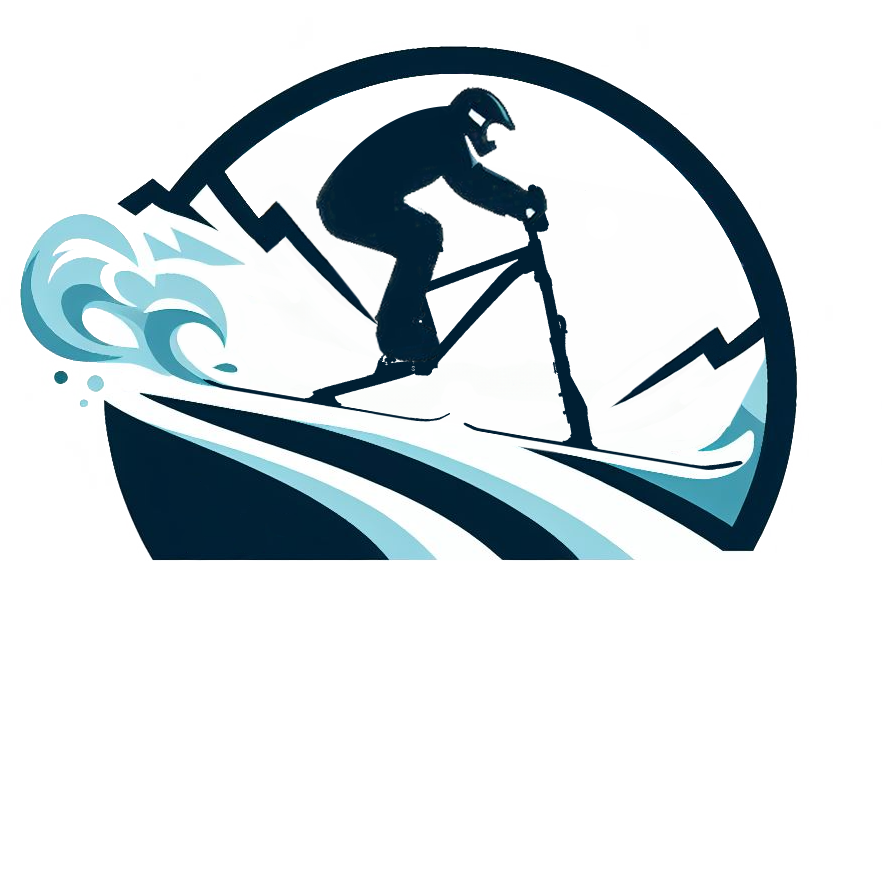FAQ
Frequently Asked Questions
What is a Ski Bike and What Are the Different Types?
A ski bike combines the structure of a bike frame with skis, replacing traditional wheels to create a thrilling way to descend snowy slopes. There are three main types of ski bikes:
- Type 1 (Skibob):
Originating from Europe, this style has a low center of gravity and is designed for seated riding. Riders often use foot skis for balance and edging, making it ideal for those seeking stability. - Type 2 (Freestyle Ski Bikes):
Inspired by mountain biking, these are built for standing or seated riding. They typically feature footrests or pegs and fully adjustable front and rear suspension. Foot skis are optional, and riders enjoy versatility across various terrains.
(At Summit Ski Bike we rent type 2 Ski-Bikes.) - Type 3 (3-Ski Design):
A trike-like design with three skis—one in the front for steering and two at the back for support. These bikes are designed for standing riders and often come equipped with front suspension for smoother rides.
How Hard is it to Learn Ski Biking?
Ski biking is surprisingly beginner-friendly! Most people gain confidence within 2-4 runs on beginner (green) and intermediate (blue) slopes. By mastering three simple techniques—skidded traverses, garland turns, and one-turn stops—you’ll be ready to tackle the mountain.
How Does Ski Biking Compare to Mountain Biking?
The learning process for ski biking is distinct from mountain biking due to the use of edges instead of tires for control. However, once you grasp the basics, you can apply familiar techniques and see the slopes as bike trails, blending the best of both worlds.
Why Do People Get Into Ski Biking?
Ski biking offers a low-impact way to enjoy the slopes, making it appealing for individuals with previous injuries, those curious about a unique winter sport, or anyone eager to try something new.
Where Can I Ski Bike, and What Are the Rules?
Many ski resorts in Colorado, including Copper Mountain, Vail, Beaver Creek, Keystone, Breckenridge, A-basin, and Winter Park, welcome Type 2 ski bikes. Each resort may have specific rules, such as:
- Ski bikes often count as an additional person on the chairlift.
- A leash (tether) is typically required for safety.
- Terrain parks or certain lifts may have restrictions.
Pro Tip: Always check with the resort in advance for their specific ski bike policies and equipment requirements.
What Do I Need to Wear?
Dress as you would for any day on the slopes:
- Jacket and snow pants
- Warm, waterproof gloves
- A helmet (a full-face helmet is highly recommended for added protection)
- Insulated footwear to keep your feet dry and warm.
Snowboard boots or warm waterproofed hiking boots
How Do You Load and Unload a Chairlift?
Loading a ski bike onto a chairlift is simpler than you might think!
- Carry the ski bike to the loading line.
- Place the ski bike between your legs and hold the front of the frame
- Sit on the chairlift making sure the saddle is on top.
- Hold the ski bike tight until you clear the ground.
- Pull the ski bike to a vertical position and pull it toward you until you can hug the saddle with your thighs
- Enjoy the ride
Note: It is possible to lower the chairlift’s safety bar and hang the ski bike’s saddle on the bar. Make sure to be at the end seats of the chairlift in case there is a resort map attached to the bar.
To unload from the chairlift:
- Simply lower the ski bike horizontally when approaching the top.
- Walk it out, or hop on and ride away.
How Do You Ride and Stop a Ski Bike?
The riding dynamics of a ski bike focus on balance, body positioning, and edge control:
- Body Position: Adopt an “attack position” with your weight slightly forward for better control.
- Stopping: Use the edges of your skis to side-slip or perform skidded traverses to slow down.
- Turns: Shift weight to the side of your intended turn, combining this with slight steering for precision.
Can You Ride Sitting or Standing?
Both! While standing is more common for downhill control, you can ride seated with a bit of extra effort. Your weight distribution will differ, so experiment to find what works best for your riding style.
Are Ski Bikes Like Regular Mountain Bikes?
Purpose-built ski bikes, like those from Lenz Sport, differ from converted mountain bike frames. These designs feature specialized geometry and head tube angles optimized for snow and chairlift compatibility. Ski biking allows you to ride the fall line with ease, offering a unique experience unlike traditional mountain biking.
What Types of Terrain Can Ski Bikes Handle?
Ski bikes are versatile, capable of tackling:
- Groomers
- Moguls
- Trees
- Powder
- Steeps and bowls
Always ride within your skill level and adhere to resort-specific rules.

